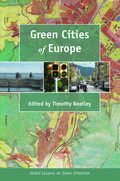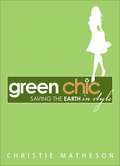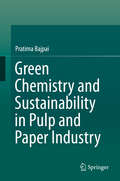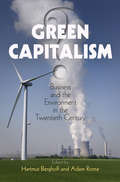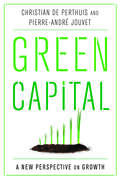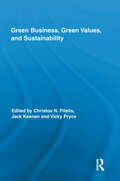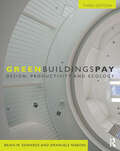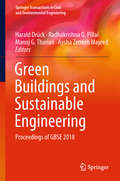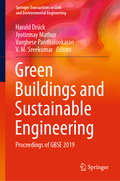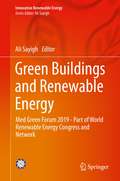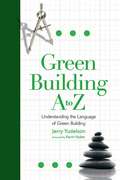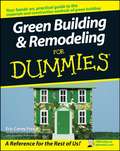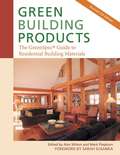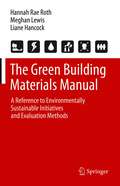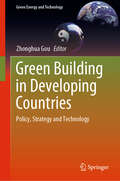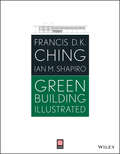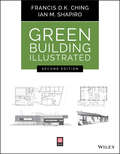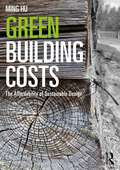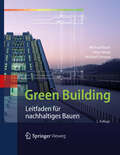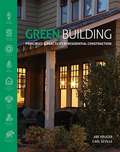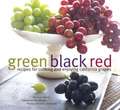- Table View
- List View
Green Cities of Europe: Global Lessons on Green Urbanism
by Timothy Beatley Maria Jaakkola Wulf Daseking Michaela Bruel Lucie Laurian Dale MedearisIn the absence of federal leadership, states and localities are stepping forward to address critical problems like climate change, urban sprawl, and polluted water and air. Making a city fundamentally sustainable is a daunting task, but fortunately, there are dynamic, innovative models outside U.S. borders. Green Cities of Europe draws on the world's best examples of sustainability to show how other cities can become greener and more livable. Timothy Beatley has brought together leading experts from Paris, Freiburg, Copenhagen, Helsinki, Heidelberg, Venice, Vitoria-Gasteiz, and London to illustrate groundbreaking practices in sustainable urban planning and design. These cities are developing strong urban cores, building pedestrian and bicycle infrastructure, and improving public transit. They are incorporating ecological design and planning concepts, from solar energy to natural drainage and community gardens. And they are changing the way government works, instituting municipal "green audits" and reforming economic incentives to encourage sustainability. Whatever their specific tactics, these communities prove that a holistic approach is needed to solve environmental problems and make cities sustainable. Beatley and these esteemed contributors offer vital lessons to the domestic planning community about not only what European cities are doing to achieve that vision, but precisely how they are doing it. The result is an indispensable guide to greening American cities. Contributors include: Lucie Laurian (Paris) Dale Medearis and Wulf Daseking (Freiburg) Michaela Brüel (Copenhagen) Maria Jaakkola (Helsinki) Marta Moretti (Venice) Luis Andrés Orive and Rebeca Dios Lema (Vitoria-Gasteiz) Camilla Ween (London)
Green Chic: Saving the Earth in Style
by Christie MathesonWant to go green without giving up great style? Not sure how to make changes--or why they matter? Welcome to the world of GREEN CHIC. Being green--thoughtfully, consciously green--makes a real difference in the fight against global warming. But did you know that it's also hip, classic, and stylish? --Look gorgeous --Love your wardrobe --Feel amazing --Travel in style --Create a home that's an oasis --Host fun parties --Eat incredible food and drink phenomenal wine --Feel more connected to your friends, family, and nature. (And did we mention that green women don't get fat?) Offering up dozens of author-tested, earth-friendly ideas, lifestyle writer Christie Matheson reveals that being chic and saving the planet aren't mutually exclusive. Can living a chic green lifestyle TRULY makes a difference? You bet your organic sheets it can. It's a calmer, more relaxed, more fabulous path that's about quality and quality of life. Embrace the fabulousness of green living. Being green isn't a fad--it's timelessly chic.
Green Chemistry and Sustainability in Pulp and Paper Industry
by Pratima BajpaiThis book features in-depth and thorough coverage of Minimum Impact Mill Technologies which can meet the environmental challenges of the pulp and paper industry and also discusses Mills and Fiberlines that encompass "State-of-the-Art" technology and management practices. The minimum impact mill does not mean "zero effluent", nor is it exclusive to one bleaching concept. It is a much bigger concept which means that significant progress must be made in the following areas: Water Management, Internal Chemical Management, Energy Management, Control and Discharge of Non-Process Elements and Removal of Hazardous Pollutants. At the moment, there is no bleached kraft pulp mill operating with zero effluent. With the rise in environmental awareness due to the lobbying by environmental organizations and with increased government regulation there is now a trend towards sustainability in the pulp and paper industry. Sustainable pulp and paper manufacturing requires a holistic view of the manufacturing process. During the last decade, there have been revolutionary technical developments in pulping, bleaching and chemical recovery technology. These developments have made it possible to further reduce loads in effluents and airborne emissions. Thus, there has been a strong progress towards minimum impact mills in the pulp and paper industry. The minimum-impact mill is a holistic manufacturing concept that encompasses environmental management systems, compliance with environmental laws and regulations and manufacturing technologies.
Green Capitalism?: Business and the Environment in the Twentieth Century (Hagley Perspectives on Business and Culture)
by Hartmut Berghoff Adam RomeAt a time when the human impact on the environment is more devastating than ever, business initiatives frame the quest to "green" capitalism as the key to humanity's long-term survival. Indeed, even before the rise of the environmental movement in the 1970s, businesses sometimes had reasons to protect parts of nature, limit their production of wastes, and support broader environmental reforms. In the last thirty years, especially, many businesses have worked hard to reduce their direct and indirect environmental footprint. But are these efforts exceptional, or can capitalism truly be environmentally conscious?Green Capitalism? offers a critical, historically informed perspective on building a more sustainable economy. Written by scholars of business history and environmental history, the essays in this volume consider the nature of capitalism through historical overviews of twentieth-century businesses and a wide range of focused case studies. Beginning early in the century, contributors explore the response of business leaders to environmental challenges in an era long before the formation of the modern regulatory state. Moving on to midcentury environmental initiatives, scholars analyze failed business efforts to green products and packaging—such as the infamous six-pack ring—in the 1960s and 1970s. The last section contains case studies of businesses that successfully managed greening initiatives, from the first effort by an electric utility to promote conservation, to the environmental overhaul of a Swedish mining company, to the problem of household waste in pre-1990 West Germany. Ranging in geographic scope from Europe to the United States, Green Capitalism? raises questions about capitalism in different historical, sociocultural, and political contexts.Contributors: Hartmut Berghoff, Ann-Kristin Bergquist, Brian C. Black, William D. Bryan, Julie Cohn, Leif Fredrickson, Hugh S. Gorman, Geoffrey Jones, David Kinkela, Roman Köster, Joseph A. Pratt, Adam Rome, Christine Meisner Rosen.
Green Capital: A New Perspective on Growth
by Christian de Perthuis Pierre-André JouvetMany believe economic growth is incompatible with ecological preservation. Green Capital challenges this argument by shifting our focus away from the scarcity of raw materials and toward the deterioration of the great natural regulatory functions (such as the climate system, the water cycle, and biodiversity). Although we can find substitutes for scarce natural resources, we cannot replace a natural regulatory system, which is incredibly complex. It is therefore critical that we introduce a new price into the economy that measures the costs of damage to these regulatory functions. This change in perspective justifies such innovations as the carbon tax, which addresses not the scarcity of carbon but the inability of the atmosphere to absorb large amounts of carbon without upsetting the climate system. Brokering a sustainable peace between ecology and the economy, Green Capital describes a range of valuation schemes and their contribution to the goals of green capitalism, proposing a new approach to natural resources that benefits both businesses and the environment.
Green Capital
by Michael Westlake Pierre-André Jouvet Christian De PerthuisChallenging the certainty that ecological preservation is incompatible with economic growth, Green Capital shifts the focus from the scarcity of raw materials to the deterioration of the great natural regulatory functions (such as the climate system, the water cycle, and biodiversity). While we can find substitutes for scarce natural resources, we cannot replace a natural regulatory system, which is incredibly complex. It is then essential to introduce a new price into the economy that measures the costs of damage to these regulatory functions. This shift in perspective justifies such innovations as the carbon tax, which addresses not the scarcity of carbon but the inability of the atmosphere to absorb large amounts of carbon without upsetting the climate system. Brokering a sustainable peace between ecology and the economy, Green Capital describes a range of valuation schemes and their contribution to the goals of green capitalism, proposing a new, practical approach to natural resources that benefits both businesses and the environment.
Green Business, Green Values, and Sustainability (Routledge Studies in Corporate Governance)
by Vicky Pryce Christos N. Pitelis Jack KeenanToday greenness is goodness; non-greenness is not an option. It is therefore critical to advance thinking on why and how business, consumers and policy makers can contribute to the goal of sustainable global wealth creation. This volume analyzes the strategic sustainability issues confronting contemporary business, and explores the transformation in values, strategies, and practices needed by modern businesses to attain sustainable business. It is is developed from a Global Business Symposium organized by the Centre for International Business and Management (CIBAM) at Cambridge University in February 2009, which brought together leading academics, scientists and engineers, government leaders, and business executives to consider the transformation in business values and strategies implicit in sustainability. Green Business, Green Values and Sustainability offers a concise and definitive book on the green transformation of business in major sectors including government, finance, energy, and retail. Different solutions to sustainability are explored including ethical approaches, alternative environmental strategies, corporate responsibility, and carbon reductions.
The Green Bundle: Pairing the Market with the Planet
by Magali A. Delmas David ColganThe market for green products has expanded rapidly over the last decade, but most consumers need something more than eco-benefits to motivate their purchases. Magali A. Delmas and David Colgan argue that many green products now offer the total package—a "green bundle" that checks the environmental box, but also offers improved performance, health benefits, savings, and status. To help consumers cut through the noise and make their best decisions, we need new strategies. The Green Bundle offers some of the best and most effective communication techniques for pushing consumers in the right direction. Framing product benefits to motivate behavior is the key. Combining insights from sustainable business and behavioral economics, Delmas and Colgan show managers how to lead buyers from information to action. If you are looking to win over the convenient consumer or understand how companies can create the next tipping point in green consumption, this is the research-based, practical guide for you.
Green Buildings Pay: Design, Productivity and Ecology
by Brian W. Edwards Emanuele NaboniThis third edition of Green Buildings Pay presents new evidence and new arguments concerning the institutional and business case that can be made for green design. The green argument has moved a long way forward since the previous edition, and this fully updated book addresses the key issues faced by architect, engineer and client today. Green Buildings Pay: Design, Productivity and Ecology examines, through a range of detailed case studies, how different approaches to green design can produce more sustainable patterns of development. These cases are examined from three main perspectives: that of the architect, the client and the user. Completely revised with all new chapters, cases, sections and introductory material the third edition presents: over 20 new researched case studies drawn from the UK, Europe and the USA, written in collaboration with the architects, engineers, clients and user groups examples of office and educational buildings of high sustainable and high architectural quality an exploration of the architectural innovations that have been driven by environmental thinking, such as the new approaches to the design of building facades, roofs, and atria cases which demonstrate current practice in the area of energy/eco-retrofits of existing buildings documentation of the benefit impact assessment schemes such as LEED and BREEAM have had upon client expectations and on design approaches over the past decade beautiful full color illustrations throughout. In the fast evolving arena of green building, the book shows how architects are reshaping their practices to deal with ever more demanding energy standards and better informed users and corporate clients.
Green Buildings and Sustainable Engineering: Proceedings of GBSE 2018 (Springer Transactions in Civil and Environmental Engineering)
by Harald Drück Radhakrishna G. Pillai Manoj G Tharian Aysha Zeneeb MajeedThis book comprises the proceedings of the International Conference on Green Buildings and Sustainable Engineering (GBSE 2018), which focused on the theme “Transforming our Built Environment through Innovation and Integration towards a Smart and Sustainable Future”. The papers included address all aspects of green buildings and sustainability practices in civil engineering, and offer a valuable reference resource for researchers, practitioners, and policy makers.
Green Buildings and Sustainable Engineering: Proceedings of GBSE 2019 (Springer Transactions in Civil and Environmental Engineering)
by Jyotirmay Mathur Harald Drück Varghese Panthalookaran V. M. SreekumarThis book comprises the proceedings of the International Conference on Green Buildings and Sustainable Engineering (GBSE 2019), which focused on the theme “Ecotechnological and Digital Solutions for Smart Cities”. The papers included address all aspects of green buildings and sustainability practices in civil engineering, and focus on ways and means of reducing pollution and degradation of the environment through efficient usage of energy and water. The book will prove a valuable reference resource for researchers, practitioners, and policy makers.
Green Buildings and Renewable Energy: Med Green Forum 2019 - Part of World Renewable Energy Congress and Network (Innovative Renewable Energy)
by Ali SayighThis book highlights selected papers presented during the bi-annual World Renewable Energy Network’s 2019 Med Green Forum. This international forum highlights the importance of growing renewable energy applications in two main sectors: Electricity Generation and Sustainable Building. The papers highlight the most current research and technological breakthroughs illustrating the viability of using renewable energy to satisfy energy needs. Coverage includes a broad range of renewable energy technologies and applications in all sectors – electricity production, heating and cooling, agricultural applications, water desalination, industrial applications, and transport. Presents leading-edge research in green building, sustainable architecture, and renewable energy;Covers a broad range of renewable energy technologies and applications in all sectors;Contains case studies and examples to enhance practical application of the technologies presented.
Green Building A to Z
by Jerry YudelsonGreen building is the fastest-growing trend to hit since the Internet, bringing with it an enormous range of new products, systems, and technologies. Green Building A to Z is an informative, technically accurate, and highly visual guide to green building, for both decision-makers and interested citizens. It begins with an introduction to the importance of green buildings and a brief history of the green building movement, outlines the benefits and costs of green buildings, and shows how you can influence the spread of green buildings. The book touches on key issues, such as enhancing water conservation, reducing energy use, and creating a conservation economy. The book examines all aspects of green buildings, including: Architecture 2030 Locally sourced materials Natural ventilation Solar energy Zero-net-energy buildings More than just a reference, this book emphasizes the importance of green buildings and green developments for a sustainable future. It will be an invaluable resource for businesspeople, homeowners, product manufacturers, developers, building industry professionals, and government officials.
Green Building & Remodeling For Dummies
by Eric Corey FreedWant to build responsibly, reduce waste, and help preserve the environment? Green Building & Remodeling For Dummies is your friendly, step-by-step guide to every facet of this Earth-friendly method of construction. Building a home--even a green home--uses plenty of resources and energy. This practical, hands-on book shows you how to build or remodel conscientiously, whether your dream home is a simple remodel or a brand-new multimillion-dollar mansion.You'll start by identifying green materials and sizing up potential systems and construction sites. You'll weigh the pros and cons of popular green building methods and identify opportunities for saving money in the long run. Need to find some green professionals to assist you in your venture? We'll help you do that, too. This book will also help you discover how to:Understand the lifecycle of building materialsChoose the right system for your green building projectPut together a green teamWork within your budgetUse green building methods and sustainable systemsSpeed construction and reduce energy use and wasteRefinish old fixtures and materialsBeware of asbestos and lead-paint hazardsAvoid costly mistakesComplete with lists of ten green things to do on every project and ten things you can do right now in your home in order to go green, Green Building & Remodeling For Dummies is your one-stop guide to planning and building the home you've always wanted.
Green Building Products
by Mark Piepkorn Alex WilsonInterest in sustainable, green building practices is greater than ever. Whether concerned about allergies, energy costs, old-growth forests, or durability and long-term value, homeowners and builders are looking for ways to ensure that their homes are healthy, safe, beautiful, and efficient.In these pages are descriptions and manufacturer contact information for more than 1,400 environmentally preferable products and materials. All phases of residential construction, from sitework to flooring to renewable energy, are covered. Products are grouped by function, and each chapter begins with a discussion of key environmental considerations and what to look for in a green product. Over 40 percent revised, this updated edition includes over 120 new products. Categories of products include: Sitework and landscaping Outdoor structures Decking Foundations, footers, and slabs Structural systems and components Sheathing Exterior finish and trim Roofing Doors and windows Insulation Flooring and floor coverings Interior finish and trim Caulks and adhesives Paints and coatings Mechanical systems/HVAC Plumbing, electrical, and lighting Appliances Furniture and furnishings Renewable energy Distributors and retailers An index of products and manufacturers makes for easy navigation. There is no more comprehensive resource for both the engaged homeowner and those who design and build homes.Editor Alex Wilson is president of BuildingGreen, an authoritative source for information on environmentally responsible design and construction, which also publishes Environmental Building News.Co-editor Mark Piepkorn has extensive experience with natural and traditional building methods.
The Green Building Materials Manual: A Reference to Environmentally Sustainable Initiatives and Evaluation Methods
by Hannah Rae Roth Meghan Lewis Liane HancockEvaluating building materials for environmental sustainability is a complex prospect. How do governmental agencies and the design industry actually measure sustainable initiatives and environmental impacts? This book breaks down the technical vocabulary and principles that define environmentally sustainable choices across interior and exterior architectural products to help the reader understand: Material ingredient selectionEnergy and water useEmissions, including greenhouse gasesHuman health and toxicitySocial accountability assessment This guide explains the structure of green certifications, standards and ecolabels, life cycle assessment, environmental regulations, and more. It presents a historic timeline for context and a snapshot of current trends and future objectives. It is a comprehensive reference for interior designers, architects, building owners, contractors, and students enrolled in interior design and architecture.
Green Building in Developing Countries: Policy, Strategy and Technology (Green Energy and Technology)
by Zhonghua GouThe book reveals how green buildings are currently being adapted and applied in developing countries. It includes the major developing countries such as China, Indonesia, Malaysia, Thailand, Pakistan, Cambodia, Ghana, Nigeria and countries from the Middle East and gathers the insights of respected green building researchers from these areas to map out the developing world’s green building revolution. The book highlights these countries’ contribution to tackling climate change, emphasising the green building benefits and the research behind them.The contributing authors explore how the green building revolution has spread to developing countries and how national governments have initiated their own green building policies and agendas. They also explore how the market has echoed the green building policy, and how a business case for green buildings has been established. In turn, they show how an international set of green building standards, in the form of various techniques and tools, has been incorporated into local building and construction practices. In closing, they demonstrate how the developing world is emerging as a key player for addressing the energy and environmental problems currently facing the world.The book helps developers, designers and policy-makers in governments and green building stakeholders to make better decisions on the basis of global and local conditions. It is also of interest to engineers, designers, facility managers and researchers, as it provides a holistic picture of how the industry is responding to the worldwide call for greener and more sustainable buildings.
Green Building Illustrated
by Francis D. Ching Ian M. Shapiro"Green Building Illustrated is a must-read for students and professionals in the building industry. The combination of incredibly expressive illustrations and accessible technical writing make concepts of green building on paper as intuitive as they would be if you toured a space with experts in sustainable building." --Rick Fedrizzi, President, CEO, and Founding Chair of the U.S. Green Building Council "The authors of Green Building Illustrated deliver clear and intelligent text, augmented by straightforward but compelling illustrations describing green building basics. This comprehensive book covers everything from the definition of green building, to details of high performance design, to sensible applications of renewable energy. This is a book with appeal for all architects and designers, because it addresses general principles such as holistic and integrated design, along with practical realities like affordability and energy codes. Green Building Illustrated describes a pathway for reaching Architecture 2030's carbon emission reduction targets for the built environment."--Ed Mazria, founder of Architecture 2030Francis D.K. Ching brings his signature graphic style to the topic of sustainable designIn the tradition of the classic Building Construction Illustrated, Francis D.K. Ching and Ian M. Shapiro offer a graphical presentation to the theory, practices, and complexities of sustainable design using an approach that proceeds methodically. From the outside to the inside of a building, they cover all aspects of sustainability, providing a framework and detailed strategies to design buildings that are substantively green. The book begins with an explanation of why we need to build green, the theories behind it and current rating systems before moving on to a comprehensive discussion of vital topics. These topics include site selection, passive design using building shape, water conservation, ventilation and air quality, heating and cooling, minimum-impact materials, and much more.Explains the fundamental issues of sustainable design and construction in a beautifully illustrated formatIllustrated by legendary author, architect, and draftsman Francis D.K. Ching, with text by recognized engineer and researcher Ian M. ShapiroIdeal for architects, engineers, and builders, as well as students in these fieldsSure to be the standard reference on the subject for students, professionals, and anyone interested in sustainable design and construction of buildings, Green Building Illustrated is an informative, practical, and graphically beautiful resource.
Green Building Illustrated
by Francis D. Ching Ian M. ShapiroFULLY ILLUSTRATED, UPDATED GUIDE TO THE STRATEGIC DESIGN OF GREEN BUILDINGSIn the tradition of Building Construction Illustrated, Francis D.K. Ching and Ian M. Shapiro offer a fully illustrated guide to the theory and practice of sustainable design. This guide provides architects, designers, and builders in the green design professional community a framework and detailed strategies for designing substantively green buildings. With a focus on sustainable sites, approaching and reaching net-zero energy, low and zero-water usage, minimum-impact materials and superior indoor environmental quality, this guide explains why we need to build green, as well as green building theory and advancements in the industry. This Second Edition includes: All-new case studies featuring geographically diverse buildings with proven zero energy performance Expanded coverage of zero energy building design, as well as zero water and zero waste buildings Practical guidance for the schematic design of high-performance buildings, heating and hot water system selection, building envelope details, and integrating renewable energy Advanced strategies, such as the concept of shape efficiency, and the optimal location for stairwells in buildings Additional strategies for affordability in green design and construction Updated references to the latest codes and standards This Second Edition of Green Building Illustrated is an excellent resource for professionals, students and those interested in the design and construction of sustainable buildings.
Green Building Costs: The Affordability of Sustainable Design
by Ming HuSustainability has become a driver of innovation in the built environment, but the affordability of sustainable building remains a significant challenge. This book takes a critical view of the real cost of green building. It provides readers with a non-biased evaluation based on empirical construction cost data and sheds light on the affordability of sustainable buildings. Chapters are presented in three parts. The first part lays the foundation to demystify the perception of green buildings being expensive to construct by providing empirical evidence that green buildings, even net-zero buildings, are not necessarily more expensive to build than conventional buildings. The second part presents empirical evidence, common misperceptions of a higher green building construction cost are debunked. The author offers a new framework to explain the construction cost drivers and differences of sustainable buildings: the project characteristics and project team characteristics (human factors). The third part directs the readers’ attention to the important role that human factors play in controlling and reducing construction costs, with a focus on the project design team. A lack of skills, expertise, and experience during the design phase is likely to be the biggest contributor to higher construction costs. Empirical analysis, case studies on LEED-certified buildings, and interviews with project teams are used to present a pathway to more affordable green building at the end. This will be a crucial resource for students and professionals in architecture, engineering, construction management, and planning and energy policy.
Green Building
by Michael Bauer Peter Mösle Michael SchwarzDer bew#65533;hrte Leitfaden f#65533;r das Planen, Bauen und Betreiben von nachhaltigen Geb#65533;uden jetzt in der zweiten Auflage Energieeffizientes und nachhaltiges Bauen ist heute zur Pflichtaufgabe f#65533;r Bauherren, Architekten und Planer geworden. Ganzheitliches Wissen zu effizientem W#65533;rmeschutz, innovativen Fassaden, bedarfsgerechten Raumklimasystemen, nachhaltigen Materialien und energie- und ressourcensparenden Energieerzeugungssytemen und Konstruktionen wird erwartet, obwohl am Markt immer noch eher sequentiell und nicht integral gedacht und geplant wird. Dieses Buch soll helfen, die relevanten Einfl#65533;sse zu kl#65533;ren und den Blickwinkel f#65533;r #65533;kologische Geb#65533;ude insgesamt zu erweitern. Als Handbuch und Nachschlagewerk liefert es Bauherren, Architekten, Planern, Geb#65533;udebetreibern und Portfolio-Haltern Informationen, wie bei Planung, Bau und Betrieb energieeffizient, wirtschaftlich und strategisch vorgegangen werden kann. Die Dokumentation prominenter Bauten wie die des SPIEGEL-Verlagshauses in Hamburg, des Roche-B#65533;rohochhauses in Basel oder der Deutschen Bank-T#65533;rme in Frankfurt liefert architektonisch ansprechende Beispiele und detaillierte L#65533;sungswege. Interviews mit den Architekten und Bauherren vervollst#65533;ndigen das Buch und machen es zu einem umfassenden Standardwerk #65533;ber nachhaltige Architektur.
Green Building: Principles and Practices in Residential Construction
by Abe Kruger Carl SevilleGREEN BUILDING: PRINCIPLES AND PRACTICES IN RESIDENTIAL CONSTRUCTION provides a current, comprehensive guide to this exciting, emerging field. From core concepts to innovative applications of cutting-edge technology and the latest industry trends, this text offers an in-depth introduction to the construction of "green" homes. Unlike many texts that adopt a product-oriented approach, this book emphasizes the crucial planning, processes, and execution methods necessary for effective, environmentally sound construction. This text demonstrates that Earth-friendly products and energy-efficient materials take planning in order to make a building truly green. This visionary text helps students and professionals develop the knowledge and skills to "think green" from start to finish, empowering and inspiring them to build truly sustainable homes.
Green Buddhism: Practice and Compassionate Action in Uncertain Times
by Stephanie KazaAt a time of growing environmental crisis, a pioneer of Green Buddhist thought offers challenging and illuminating perspectives.With species rapidly disappearing and global temperatures rising, there is more urgency than ever to act on the ecological crises we face. Hundreds of millions of people around the world—including unprecedented numbers of Westerners—now practice Buddhism. Can Buddhists be a critical voice in the green conversation? Leading Buddhist environmentalist Stephanie Kaza has spent her career exploring the intersection of religion and ecology. With so much at stake, she offers guidance on how people and communities can draw on Buddhist concepts and practices to live more sustainable lives on our one and only home.
The Green Book: The Everyday Guide to Saving the Planet One Simple Step at a Time
by Elizabeth Rogers Thomas M. KostigenWater is the biggest environmental issue facing us today. It's a resource we can't live without, yet most of us take it for granted as we brush, flush, and consume water seemingly without limit. We hose our driveways and over water our lawns. But all of that is about to change; we're quickly running out of our freshwater supply.
Green Black Red: Recipes for Cooking and Enjoying California Grapes
by Susan VollandGreen, black, or red, grapes have long been the stars of the snack bowl and the wine press. Now, the versatility of the grape is explored as a key ingredient in 60 recipes for every occasion.
